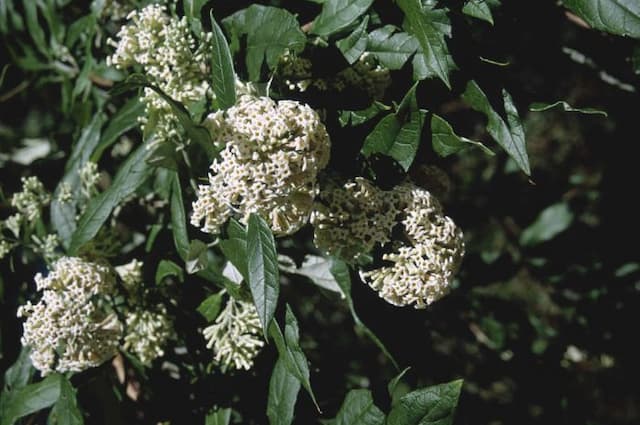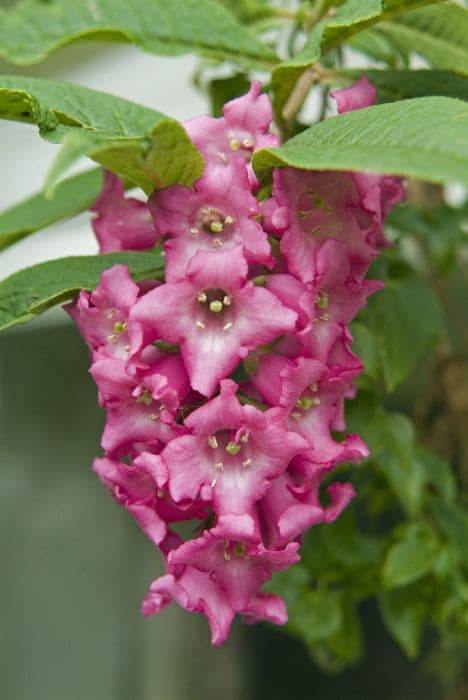Colvile's Glory Buddleja colvilei

ABOUT
The plant known as Himalayan butterfly bush showcases lush green leaves that are pointed at the tip and rounded at the base, exhibiting a smooth surface with a slightly wrinkled texture. These leaves often have finely toothed edges, contributing to the plant's ornamental charm. The most striking aspect of Himalayan butterfly bush is its blossoms which bloom in striking clusters. The flowers appear in tubular shapes and boast rich, deep pink to magenta hues, creating a vivid visual spectacle. The inflorescences, or flower clusters, dangle gracefully, providing a pendulous effect that is quite eye-catching. The blooms emit a pleasant fragrance, adding another layer of sensory appeal to the plant. The overall appearance of the Himalayan butterfly bush is one of robust vitality and colorful exuberance, making it a popular choice for gardeners seeking to add a splash of color and attract pollinators such as butterflies.
About this plant
 Names
NamesFamily
Scrophulariaceae
Synonyms
Colvile's Glory, Himalayan Butterfly Bush
Common names
Buddleja colvilei
 Toxicity
ToxicityTo humans
Buddleja colvilei, commonly known as the Himalayan butterfly bush, is not widely recognized for being toxic to humans. However, as with many plants, individuals might experience mild to moderate discomfort if they ingest parts of this plant, particularly if they have a sensitivity or allergy to it. There is limited information available on the specific toxicity and symptoms of poisoning from Buddleja colvilei in humans, so it's generally advisable to avoid eating any part of ornamental plants due to the potential risks and lack of edibility.
To pets
Buddleja colvilei, known as the Himalayan butterfly bush, is not known to be highly toxic to pets, but it can potentially cause mild gastrointestinal upset if ingested. As with humans, specific toxicity levels and symptoms from this plant are not well-documented. It is best to prevent pets from consuming any part of ornamental plants, including Himalayan butterfly bush, due to the possible risk of stomach irritation or other mild symptoms. If your pet does consume part of this plant and exhibits signs of distress, it is wise to consult a veterinarian.
 Characteristics
CharacteristicsLife cycle
Perennials
Foliage type
Deciduous
Color of leaves
Green
Flower color
Pink
Height
6-12 feet (1.8-3.7 meters)
Spread
6-12 feet (1.8-3.7 meters)
Plant type
Shrub
Hardiness zones
7
Native area
Himalayas
Benefits
 General Benefits
General Benefits- Attracts Pollinators: Buddleja colvilei is known for its ability to attract butterflies and bees, enhancing local biodiversity.
- Aesthetic Appeal: With its pink and red pendulous flowers, it provides a vibrant splash of color to any garden or landscape.
- Ease of Cultivation: This plant is relatively easy to grow and does not require extensive horticultural knowledge or care.
- Drought Tolerance: Once established, it is quite tolerant of drought, making it suitable for areas with low rainfall.
- Fast Growth: This species is known for its rapid growth rate, allowing for quick establishment and coverage.
- Screening Purposes: Due to its size and density, it can be used to create a privacy screen or windbreak in gardens.
- Habitat Creation: It can provide shelter and food for various wildlife species, contributing to the creation of micro-habitats.
 Medical Properties
Medical PropertiesThis plant is not used for medical purposes.
 Air-purifying Qualities
Air-purifying QualitiesThis plant is not specifically known for air purifying qualities.
 Other Uses
Other Uses- Buddleja colvilei, commonly known as the Himalayan butterfly bush, can be used in creating natural dyes for fabrics, with flowers offering hues of pink and leaves yielding green shades.
- The wood of the Himalayan butterfly bush is sometimes used in the construction of small household items, due to its moderate hardness and the ease of working with it.
- Because of its dense foliage, Himalayan butterfly bush can be utilized as a natural privacy screen in gardens and landscaping.
- The flowers of the Himalayan butterfly bush provide a rich source of nectar and can be used in making homemade syrups and sweeteners for culinary purposes.
- Its aromatic leaves can be dried and used in potpourri mixes to impart a fresh and pleasant fragrance to indoor environments.
- Gardeners may use the Himalayan butterfly bush as a companion plant to attract pollinators, thereby enhancing the pollination of nearby fruit and vegetable crops.
- The plant can be included in educational activities, such as botany studies and pollinator workshops, to teach about plant-pollinator interactions and biodiversity.
- Himalayan butterfly bush branches can be used in weaving or as supportive stakes for climbing plants in the garden due to their flexibility and strength.
- The striking flower panicles can be harvested and included in ornamental floral arrangements both in fresh and dried forms.
- Due to its rapid growth and dense foliage, the Himalayan butterfly bush can be employed in erosion control efforts on sloped landscapes to help retain soil.
Interesting Facts
 Feng Shui
Feng ShuiThe Buddleia is not used in Feng Shui practice.
 Zodiac Sign Compitability
Zodiac Sign CompitabilityThe Buddleia is not used in astrology practice.
 Plant Symbolism
Plant Symbolism- Rejuvenation: Buddleja, commonly known as Butterfly Bush, symbolizes rebirth and new beginnings as it attracts butterflies which are emblematic of transformation.
- Healing: The plant has medicinal properties and is therefore associated with healing and health.
- Attraction: Since it lures a variety of insects and wildlife, especially butterflies, Buddleja signifies attraction and magnetism.
- Protection: Buddleja varieties are known to be hardy and resilient, symbolizing protection and defense against adversity.
 Water
WaterThe Himalayan butterfly bush, also known as Buddleja colvilei, prefers moderate watering. During the growing season of spring and summer, water the plant when the top inch of soil feels dry, roughly once a week, with about 1-2 gallons depending on the size of the plant and environmental conditions. In hot, dry periods, you may need to water more frequently. Reduce watering in the fall and water sparingly in winter, as the plant enters dormancy, to avoid waterlogging which can lead to root rot. Always allow for good drainage to prevent excess water from stagnating around the roots.
 Light
LightThe Himalayan butterfly bush thrives best in full sun to partial shade conditions. Ideally, it should receive at least 6 to 8 hours of sunlight a day. A spot that gets morning sun and afternoon shade would be optimal to protect it from the intense heat of the late day. It can tolerate some shade, but flowering is often more prolific when the plant is situated in an area where it gets ample sunlight.
 Temperature
TemperatureThe ideal temperature range for the Himalayan butterfly bush is between 60°F and 80°F. It can withstand temperatures as low as 20°F, but it should be protected from prolonged freezing conditions. During the winter, it's best if the temperature does not drop below 30°F too often. The plant is not extremely heat-tolerant, and in areas with hot summers, it will benefit from some afternoon shade to prevent stress.
 Pruning
PruningPruning the Himalayan butterfly bush promotes healthy growth and better flowering. Prune it in late winter or early spring, before new growth begins. Remove any dead or damaged branches and cut back the previous year's growth to about a third of its length. This will encourage the plant to produce new, vigorous shoots that will flower in the summer. Prune after blooming in midsummer if the plant becomes leggy or you wish to maintain a certain shape.
 Cleaning
CleaningAs needed
 Soil
SoilHimalayan Butterfly Bush thrives in well-draining soil rich in organic matter with a pH range of 6.5 to 7.5. A mix of two parts loam, one part peat, and one part sand or perlite is ideal for this shrub.
 Repotting
RepottingHimalayan Butterfly Bush should be repotted every 2 to 3 years or when it outgrows its current pot, ensuring space for growth and root health.
 Humidity & Misting
Humidity & MistingThe Himalayan Butterfly Bush prefers moderate humidity levels but is tolerant of a wide range, making it adaptable to various environments.
 Suitable locations
Suitable locationsIndoor
Place in bright light, away from drafts, and water regularly.
Outdoor
Plant in full sun or partial shade and protect from strong winds.
Hardiness zone
7-9 USDA
 Life cycle
Life cycleBuddleja colvilei, also known as the Himalayan butterfly bush, begins its life cycle as a seed, often requiring a period of stratification to break dormancy. Upon germination, the seedling emerges and establishes roots and foliage, entering the vegetative growth phase where it develops the structure and leaves necessary for photosynthesis. As the plant matures, it enters a reproductive phase, characterized by the development of vivid pink to red inflorescences that attract a variety of pollinators, including bees and butterflies. After successful pollination, it produces seeds that are dispersed by wind, completing the cycle. In favorable conditions, the Himalayan butterfly bush can also spread vegetatively through root suckers, enabling it to create clonal colonies. This shrub is deciduous or semi-evergreen, depending on the climate, and will undergo a period of dormancy in colder seasons, during which growth and metabolic activities are reduced.
 Propogation
PropogationPropogation time
Spring-Early Summer
The most popular method for propagating Buddleja, or Butterfly Bush, is through semi-hardwood cuttings. This process typically takes place in late summer when the current year's growth has begun to mature and harden slightly. Cuttings of about 4 to 6 inches (approximately 10 to 15 centimeters) long are taken from the shrub, making sure each one has several sets of leaves. The lower leaves are removed, and the base of the cutting is dipped in a rooting hormone to encourage root development. These cuttings are then planted in a mixture of peat and perlite or sand and kept moist under a humidity dome or plastic wrap to maintain a high humidity environment. Roots usually develop within a few weeks, after which the new young plants can be gradually acclimatized to less humid conditions before being planted out the following spring.

![Butterfly bush [Berries and Cream]](/_next/image?url=https%3A%2F%2Fplants-admin.emdemapps.com%2Fimages%2Fplants%2F%2Fimages%2F604b650f667be.png&w=640&q=75)




![Butterfly bush [Nanho Purple]](/_next/image?url=https%3A%2F%2Fplants-admin.emdemapps.com%2Fimages%2Fplants%2F%2Fimages%2F604b5e3cb2c58.png&w=640&q=75)

